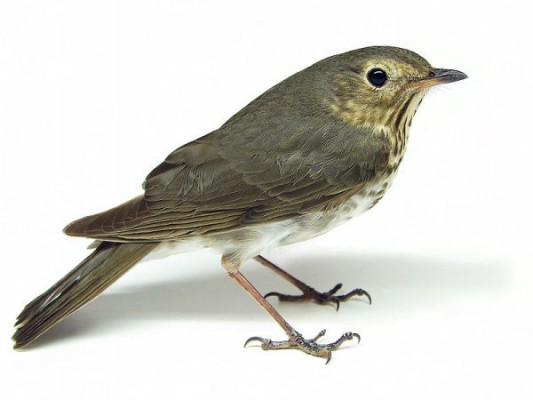If you’re a Swainson’s thrush of mixed parentage you’ll probably pick a bad migration route. It’s in your genes.
In eastern North America we see only one subspecies of Swainson’s thrush, the olive-backed (above), but in British Columbia there are two. The russet-backed subspecies breeds along the Pacific coast and follows the coast to spend the winter in Mexico and Costa Rica. The olive-backed subspecies breeds in the interior and migrates across the continent and the Gulf of Mexico to winter in South America.
Where their breeding ranges meet the thrushes pair up without regard to these distinctions. Their hybrid offspring inherit a mixture from their parents, including mixed coloration.
Kira Delmore at the University of British Columbia wondered if the hybridization extended to their migration routes so she tagged hybrid Swainson’s thrushes with light-level geolocators to track their routes.
The data proved that their migration routes are inherited and that those of mixed parentage inherit a blend. While each parent would have followed the Pacific coast or a safe route across the continent, the hybrids chose novel and dangerous compromises between the two paths.
“Instead of taking well-trodden paths through fertile areas, these birds choose to scale mountains and cross deserts,” said Delmore.
The dangerous routes probably cause more hybrids to die on migration than their pure counterparts, thus keeping the subspecies distinct. Says Delmore, “The self-destructive behavior of hybrids could be helping to maintain the great diversity of songbirds we enjoy.”
Read more about this study here at Science Daily.
(photo by Matt Reinbold from Wikimedia Commons. Click on the image to see the original)

Kate–Is there a web map where I can find general info on standard migration patterns thru the Eastern US? I was lucky enough to be driving thru the Allegheny Front area several years ago, and was stupefied (!) by the birds passing thru. My husband grew up in Sharon PA and remembers massive migrations of something going thru. I thought maybe from Magee Marsh, but that’s significantly further west. Any direction? (Pun intended.)
Anne
Anne, Here’s a blog post from 2012 that has the migration flyway map and links to other migration websites. http://www.birdsoutsidemywindow.org/2012/04/13/why-birds-get-here-last/
I find this fascinating. It brings more questions to the mystery of migration for me. Are the routes indeed inherited or is the capacity to discern routes inherited? Perhaps, the cross-breeding is effecting more than the bird’s appearance. Perhaps, the cross-breeding is producing a bird with compromised navigational faculties versus a scrambled instruction sheet. I’m not sure if I’m saying this properly. I’m still trying to wrap my mind around it, but I guess what I’m saying is, “Is it an instruction sheet they inherit (like mapquest) or the ability and interact with environmental clues that guide them through the proper channels or flyways. Perhaps, it’s both. The tendency for a bird to return to the area of its birthplace to breed is another intriguing area of interest. Fascinating.